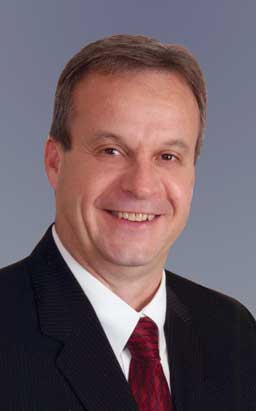President’s message
Barriers: real or artificial?
My wife Betsy and I recently moved. Leaving a house that has been your home for 15 years, where your kids grew up, can be tough. One can accumulate a lot of treasures (junk?) in that amount of time. Sorting through stacks of keep-or-culls can be overwhelming. We tell our children that doing this now is saving them much future agony of sorting, if we had remained in this same house until the end of our days and had left the task to them. We offer that explanation as we place boxes with their names attached into their cars as they leave after a visit. One accumulates a lot of memories in 15 years as well. The emotional sorting takes more time and creates more hesitancy for change. During these ups and downs, we work at focusing on the excitement of the adventure and what the future holds.
Previous positive or negative experiences can limit our willingness to explore opportunities. Are we open enough as swine veterinarians and as an association to consider the opportunities that inevitable change will offer?
Our dog, Logan, to our relief, is making the transition splendidly from 8 acres in the country to half an acre in a suburb. He has more people to watch from the front lawn, three young neighbor girls that love to come by and play, and there is a whole new world to mark as his territory. At our old house we had an invisible fence. We reinstalled the system at the new address using the white flags to mark the boundaries. It had been over 4 years since he had seen the white flags, but Logan had the flag memory deeply imprinted, as he put the brakes on long before he came close to those white flags and associated invisible fence. There is no need to worry if the batteries are working in his collar, as he is keeping a wider than necessary distance from the line marked with the flags. He likes investigating the backyard, but his flag sensitivity has led to challenges in moving along the sides of the house. While there is more then enough safe-zone width between the flags and the house, he will not take that path to the backyard on his own, because the space is narrower and he sees the white flags. The geography has changed and there is a safe bridge to travel, but from past experience, he will not take the risk to go where he wants to be.
How many times personally or as an association do we see barriers that do not actually exist? How often have we stepped out, received a correction, and then never re-explored the opportunity once the barriers are removed?
Recently, a friend was relating the results of a study involving monkeys and bananas. To paraphrase his summary, five monkeys were placed in a room with their favorite food, bananas, suspended from the ceiling but within reach. Each time the monkeys attempted to reach and get the bananas they were sprayed with cold water. Eventually the monkeys stopped attempting to get the bananas and became satisfied with the other less desirable food. Next, one monkey in the group was replaced with a new one. What do you think happened when the new monkey attempted to reach for the suspended bananas? The other monkeys grabbed him to keep him from attempting the retrieval. Then a second and a third and a fourth and a fifth monkey were replaced in the group until none of the five that remained had been present during the original water spraying. Each time the behavior was the same: when the new monkey started to reach for the banana, the group grabbed him to keep him from attempting it, even when at the conclusion all five of the monkeys that remained had never been sprayed.
Veterinary medicine and swine production are in a transformation period. Probably the swine veterinarians that started AASP in the late 60’s thought the same thing then, but were willing to test the boundaries and tackle something new. Some barriers are real, but as an association, how often do we see artificial barriers on what can and should be the future?
As individual swine veterinarians, how often have we missed opportunities in welfare, food safety, finance, or training due to preconceived beliefs that are no longer accurate?
These are exciting times. Enjoy becoming part of the future. If traveling through Indianapolis, stop in and see us. You can help, as we still have boxes to unload and some treasures yet to give away. Or is that treasures to unload and boxes to give away? Whatever. If nothing else, stop and have a banana.
--Kerry Keffaber, DVM

